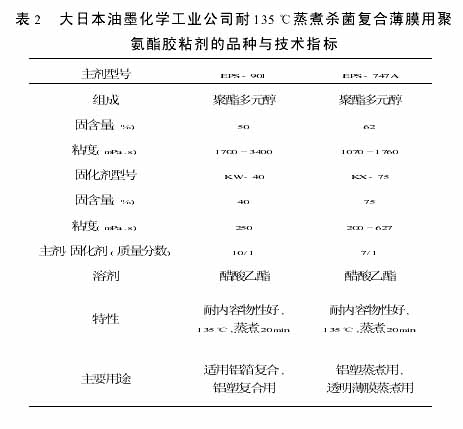
2.2 Polyfunctional Polyester Polyurethane Adhesives
By partially cross-linking the macromolecules, the crosslinking density is increased so that the heat resistance of the adhesive is improved. In the synthesis of polyesters, the introduction of trifunctional or more functional groups can cross-link macromolecules, thereby increasing the heat resistance of the glue. A high temperature resistant cooking adhesive developed by the Printing Technology Research Institute of Liaoning Province, using lauric acid, phthalic acid, adipic acid, glycerol, trimethylolpropane to prepare a component, and then reacted with an isocyanate compound to make a Polyurethane adhesive. This plastic has good resistance to 125°C retort and has high adhesive strength and good flexibility to plastic films. US COUGHLINJAMES [9] synthesizes polyester diols with ethylene glycol, hexanediol and isophthalic acid, terephthalic acid, and then uses p-toluene diisocyanate to modify to obtain isocyanate-based prepolymers. Then, a polyfunctional polyester polyol with trimethylolpropane, ethylene glycol, hexanediol, and isophthalic acid, terephthalic acid synthesized is mixed with an isocyanate-terminated prepolymer to obtain a Polyurethane Adhesive. Due to the introduction of multi-functional groups and rigid heat-resistant structures in the structure, the adhesive has increased cross-link density, improved heat resistance, and good boiling water resistance.
2.3 Modified Polyurethane Adhesive
In order to improve the heat resistance of polyurethane adhesives, modifiers are often added to their formulations, mainly epoxy resins. Modification with an epoxy resin can make full use of the rigid, heat-resistant structure of the epoxy molecule and the hydroxyl groups on the molecular chain that react with the isocyanate. The reaction of the hydroxyl group with the isocyanate can increase the entanglement and cross-linking between the macromolecules, so that the heat resistance of the adhesive is improved. Zhejiang Huangyan Oriental Ink Chemical Co., Ltd. and the Department of Chemistry of Hangzhou University jointly developed the HE-95(A), a cooking resistant adhesive for PET/AL/CPP dry composites with similar properties to the AD-502. It is different from general two-component polyurethane adhesives in that the main agent is not a polyisol (polyester or Polyether) with a low molecular weight and is derived from diisocyanate chain extension, but is a polycondensation reaction of a mixed dibasic acid and a mixed glycol. be made of. The one-step high molecular weight copolyester (M>6000) is physically or chemically blended with the modified resin without chain extension to achieve high heat resistance and excellent fastness. The peel strength of the adhesive at 180°C and the peel strength after cooking at 121°C/40min all reached the level of AD-502/CAT-10 adhesive produced in Japan.
3 Research prospects
With the rapid increase in the amount of retort food packaging bags, the amount of polyurethane adhesives is also increasing. Cooking bags in Europe, the United States, Japan and other developed countries increased by an average of more than 10% from 1990 to 1998. In China, cooking foods have long been commercialized, with an average annual increase of more than 12%. Domestic adhesives used as cooking foods have so far mostly been imported, and domestically produced products are still unable to meet cooking requirements. The imported brands include AD502/CAT-10, EPS901/KW80, UK3640, UK6800 and A-310/A-3. Wait. Which AD502/CAT-10 accounted for most of the market share. Therefore, the localization of polyurethane adhesive for composite films with low viscosity, high solid content, high strength and high temperature resistance (135 °C, 30 min) is the development direction. At the same time, the market demand for adhesives is also increasing. Hydrolysis of aromatic diisocyanates commonly used produces diaminotoluene, a moderately carcinogenic substance that is detrimental to food packaging. The use of aliphatic isocyanate to prepare polyurethane adhesives does not present this problem, but due to its high price, it cannot be used on general products and domestic demand cannot be met. Aliphatic isocyanates have been used in foreign countries instead of aromatic isocyanates to produce high-temperature cooking polyurethane adhesives. This is a general trend.
Zhang Shengwen, Wang Tingwei (Department of Polymer Science, School of Materials Science and Engineering, Nanjing University of Chemical Technology)





